I can’t believe it’s already February! All of January I was busy setting up my goals and trying to create a tracking system where I can see the whole picture easily. With the help of my husband, I created an amazing excel file which helps you do just that! Keep reading to learn how you can create a SMARTER 12 Week Goals System.
You may have already heard about the 12 Week Year from Brian Moran, it’s an amazing way to set goals. Instead of planning goals for the year, you only focus on the next 12 weeks. It’s a great way for you to stay focused because it’s a short enough time for you to not procrastinate and delay getting started, yet it’s still long enough for you to get stuff done.
I love the 12 Week Year System because it is very systematic. It helps you to break down you big picture goals to simple day-to-day tasks. The end is in sight which makes it easier for you to stick to your goals, and it forces you to take action right away because 12 weeks will fly by!
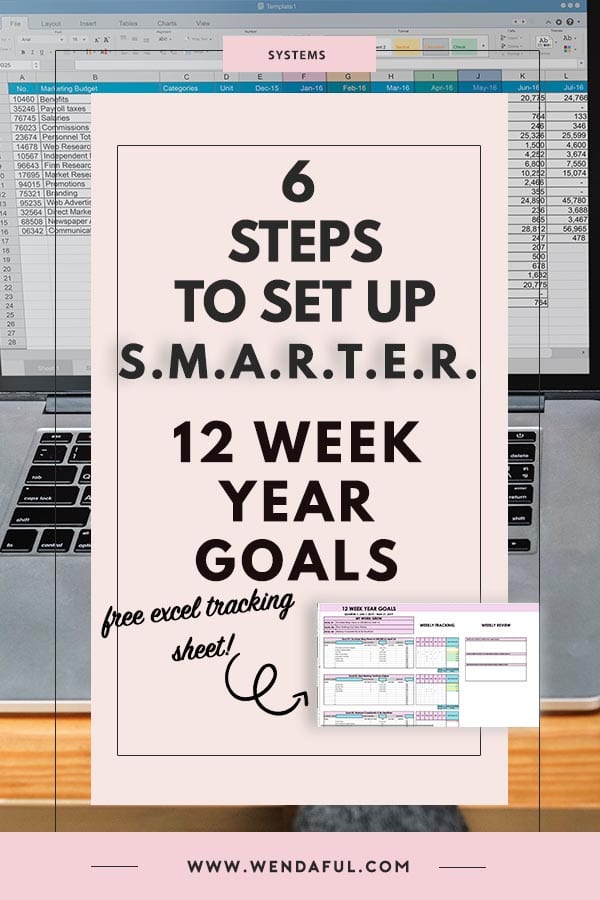
Be sure to sign up and download the Excel file to help you plan, schedule and track your 12-week year goals every week!
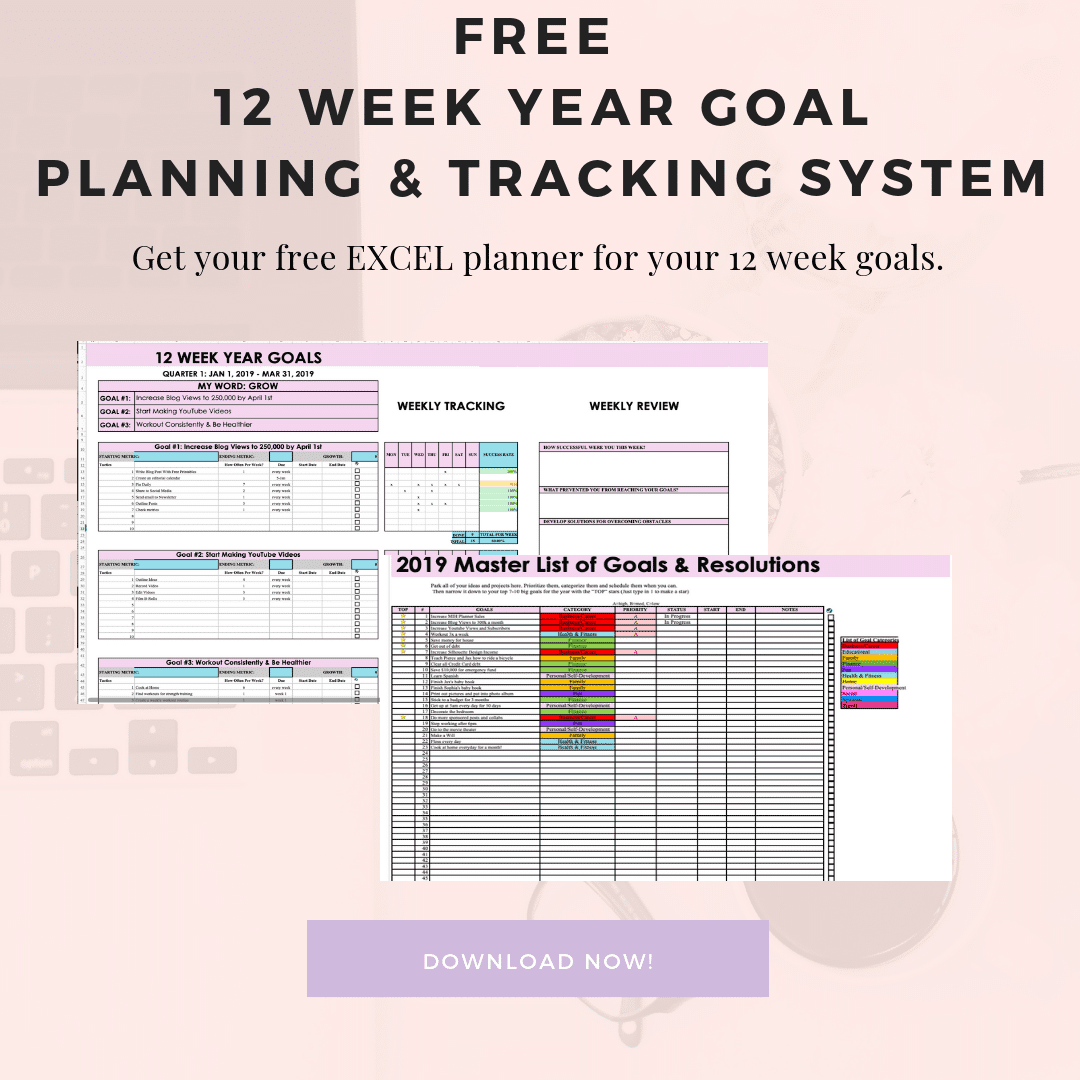
Creating a step-by-step list of your goals and keeping it visible, makes sure that you can review it every day. You will always see where you want to go. You will also be able to visualize the roadmap to achieving your goals more clearly. Having your goals planned out also gives you an idea of what you need to do as well as the things you need to avoid doing to make them a reality. It is an efficient way of keeping them at the forefront of your mind all the time.
Now let’s get started on how to set up your 12-week year goals
Table of Contents
Step 1: Map Out Your Vision and Goals
The first step is to come up with a long-term vision for your life. This is helpful for when you are feeling unmotivated. This vision will help you to stay on track and keep working towards your goals each and every day. This will be your why.
I always like to start with future 5-10 year dream goals, then scale it back to 3-year goals and finally 1-year goals.
A way that I find that helps build my vision is by answering the following question: “At the end of 2019, I want to be/have/do/finished/accomplished _____________”‘
To make it even more powerful I use visualization and pretend it’s already the end of the year or quarter and I am telling my friend all about my accomplishments over the last year. The goals you set become so much more concrete in your mind when you can also visualize them and believe that you’ll reach them. I like to journal and write it all down like it already happened.
The first step in effective visualization is to pull all your senses into the process. If your goal is a new, larger home, imagine how it feels to walk around in that house with ample room. Visualize yourself making a meal in the large kitchen. You’re surrounded by the sounds of a happy family, the smells of good food cooking and the feeling you have everything needed, organized and at your fingertips.
Utilizing the senses in this way when you visualize will help secure this goal within your subconscious mind, and effectively make it easier to take the actions you need to take to work towards your goals. Your actions will follow your thoughts, so make visualization a part of your daily routine!
In the excel file, I have a place where you can list out all of your goals and resolutions. I like having a maser/someday list to just have it written somewhere. In this list, you can categorize it, prioritize and mark if it was finished.
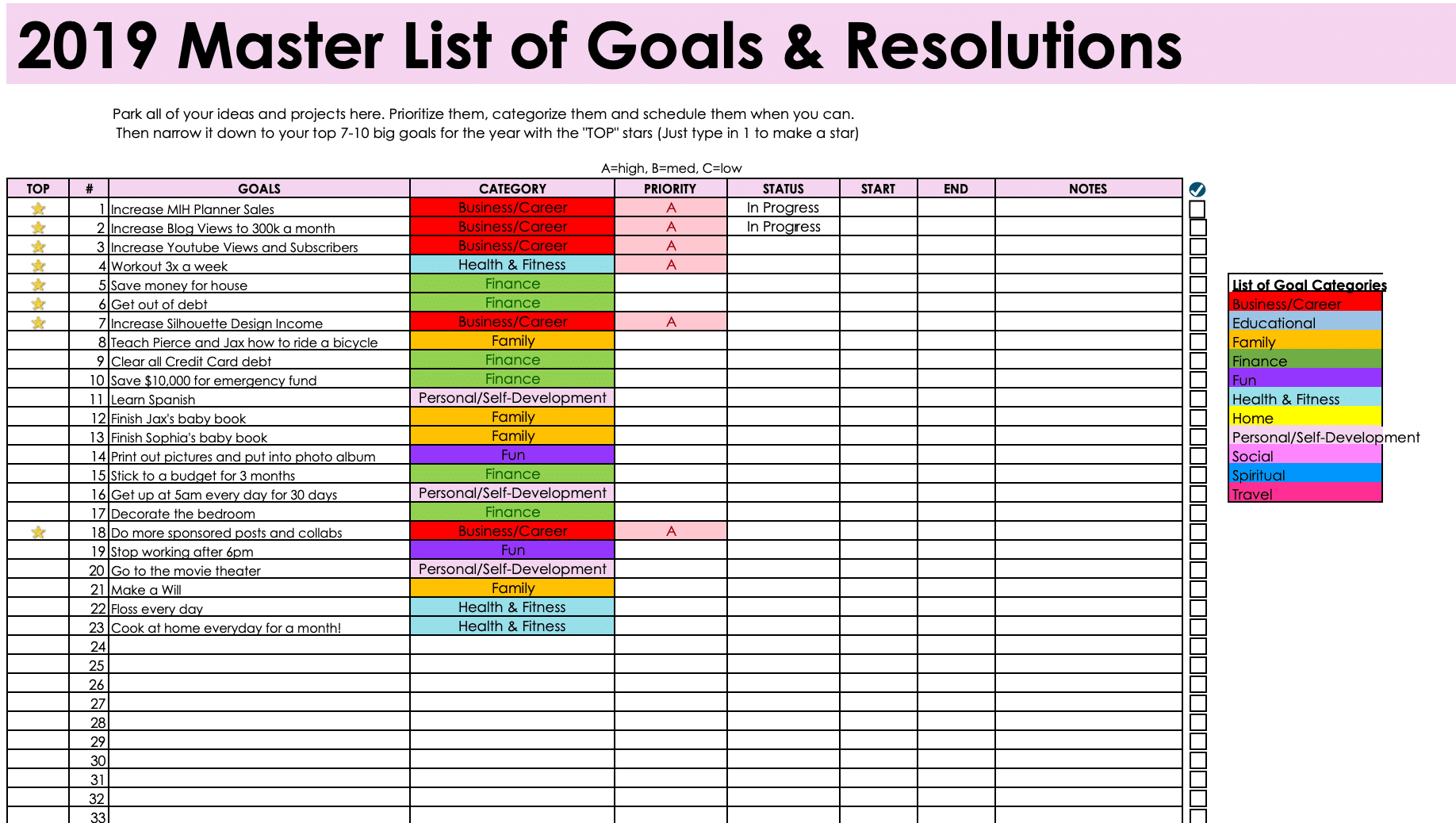
Step 2: 12-Week Goals
After I have set up my big goals I like to think of goals for different areas of my life. Then I think about what is a priority and I want to achieve over the next 12 weeks.
Smaller interim goals are necessary to ensure your road to success is a smooth one. It becomes too overwhelming to set one goal of “I will buy a bigger home next year”. That can be an excellent end goal, but you need to break it down to make it more achievable.
Smaller, more readily achievable goals in this scenario would be, “Pay off all credit card debt”, “save 20% down payment”, and “raise credit score”. Achieving these smaller goals or milestones sets you up for success in your major end goal.
smarter goals
When writing my goals I use the acronym S.M.A.R.T.E.R to set my goals. It’s like the original SMART goals except includes two more very crucial steps into your goal setting:
- S – Specific – What do you want to accomplish? Who needs to be included? When do you want to do this? Why is this a goal?
- M – Measurable – How can you measure progress and know if you’ve successfully met your goal?
- A – Achievable – Do you have the skills required to achieve the goal? If not, can you obtain them? What is the motivation for this goal? Is the amount of effort required on par with what the goal will achieve?
- R – Relevant – Why am I setting this goal now? Is it aligned with overall objectives?
- T – Time-bound – What’s the deadline and is it realistic?
- E – Evaluate – What is working, what isn’t? Are the tasks you’re doing moving you toward success? If not, why not? What can you tweak, change or get rid of to make them work?
- R – Reward – What are some rewards you can set up for yourself as motivation for reaching your goals?
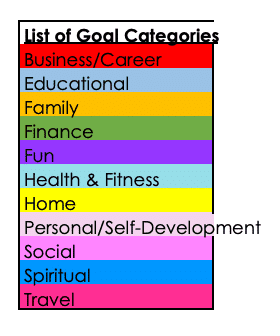
For the next 12 weeks, you should focus on only 1-3 goals and be sure it’s spread out into different areas of your life. I always like to have at least one business goal and one health goal. Here’s an example of some of my goals for my first 12 weeks this year:
BLOG: “Increase my monthly blog views to 250,000 by April 1st, 2019 so I can earn more income”
HEALTH/FITNESS: “Start working out at the gym consistently for 3 days a week for the next 12 weeks”
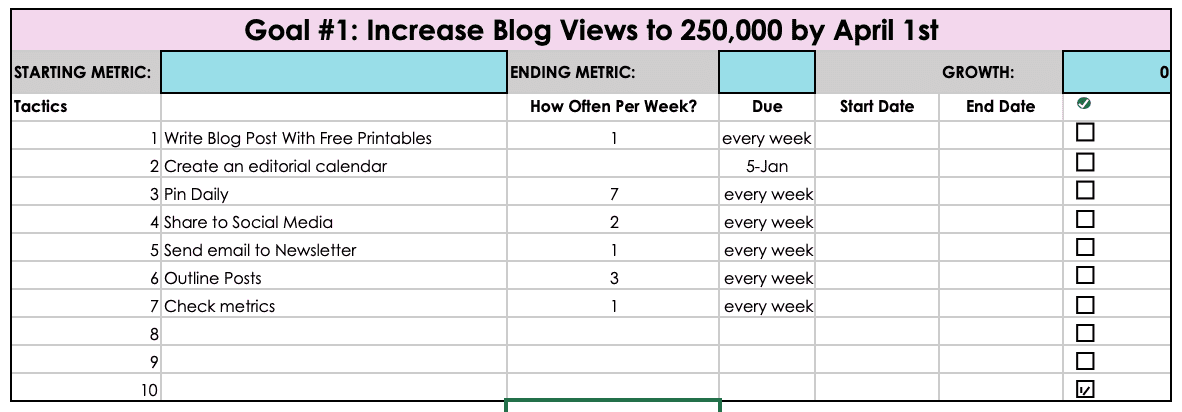
Step 3: Braindump & Prioritize All Action Steps
Now that I have set my SMARTER goals, it’s time to think of all the ways I can make it happen. Write down a list of all the action steps needed to reach your goals. Don’t worry about the order, just think of every little thing you need to do to reach your goals. After it’s all laid out then rearrange it into a logical order. Then, follow these steps religiously as it is your roadmap that you will use to execute your plan as flawlessly as possible.
Each action you plan should be related directly to meeting your goal.
For example for my blog view goal these are the steps I need to take:
- Brainstorm themes and blog posts for the entire 12 weeks
- Create an editorial calendar and set deadlines
- Schedule a day of the week of batch write
- Outline and brainstorm ideas every morning
- Take pictures of my planners and systems
- Create videos for my blog posts
- Share my blog posts on social media
- Pin my blog posts daily
- Set up an RSS feed to email my newsletter weekly
After listing out everything, think about the tasks that will help you reach your goals the most. Check it against your goal to ensure you aren’t getting sidetracked with activities that are of little importance. You want to focus on the things that will definitely help you. For my goal, I know that writing and posting consistently and sharing my posts will be the most crucial to my success.
Step 4: Set Deadlines
“What gets scheduled, gets done” Be sure to set deadlines to your action steps. When will you get these actions done? Which week will it need to be done by? If it’s something you need to do every week just put a due date of every week and track it every week.
Step 5: Schedule Actions into Your Weekly/Daily Plan
Now that you know when things are due, create an ideal weekly schedule and figure out when you will work on these actions. You can watch my video here to learn more about how to create your ideal week.
Try to spread it out throughout the weeks so you aren’t doing too much and getting overwhelmed.
Remember to prioritize the tasks so that you are sure to get the most important task completed
When you schedule your actions you will start to see how these goals can be achievable and see how everything falls into place.
When planning your weekly schedule, Brian Moran, author of the 12 Week Year suggest you use three types of time blocks:
- Strategic Blocks – 3 hours of focus time. In these time blocks, all energy goes to your pre-planned tasks.
- Buffer Blocks – These are used to handle the small, miscellaneous and unexpected tasks that need to get done each day. For example, replying to emails or commenting on social media. You should limit these to only 1-2 per day, for 30 minutes.
- Breakout Blocks – 3 hours of non-work related activity during your workday
Review your schedule and action steps often so that you stay on track and stay motivated.
Step 6: Track and Review
Each week set aside time to go over your goals. Check your plans and see if you’re on track. Track your actions so that you can quickly see if something isn’t working the way you expected it to. That offers you the chance to change what isn’t working without wasting a lot of time.
In the excel file, I provide, there’s a built-in tracking system that you can reuse each week. In each row there is a task you wrote down, and you specified whether you will do it 3 days a week or 7 days a week, in the weekly tracking table yo simply mark an x (or any letter or number you want, it doesn’t matter) into the day of the week you completed it, and it will track the percentage of completion for you. So if you wanted to go to the gym 4 days a week but you only went on Monday and Wednesday, then your completion would only be 50%. Your goal should be to at least get 80% in your total weekly completion success to have a successful week in reaching your goals. (*Note that the weekly success rate would only work for tasks that occur every week)
Also note that if you download the Google Sheets version, some of the features won’t work there.
I also added blue boxes in the goal boxes to help you keep track of your starting and ending metrics. Keeping track of your metrics will help you focused on your goals. Just being aware of your numbers can help you tremendously.
By doing this, you will learn to discipline yourself to follow your goals. You’ll be able to track your progress at the end of the day and see whether you’re on the right path.
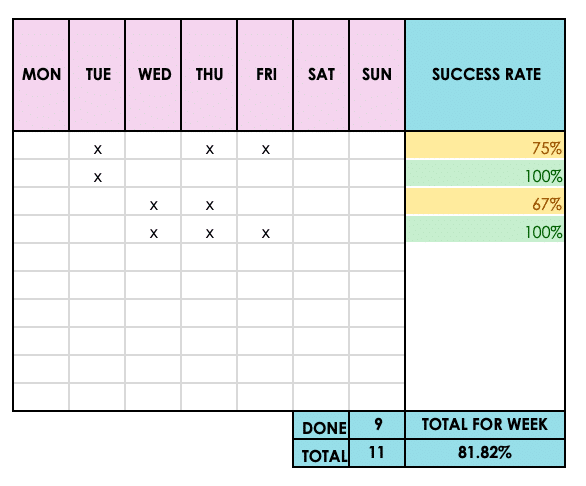
There are also some prompts to help you review your week:
- HOW SUCCESSFUL WERE YOU THIS WEEK?
- WHAT PREVENTED YOU FROM REACHING YOUR GOALS?
- DEVELOP SOLUTIONS FOR OVERCOMING OBSTACLES.
keep a journal of the process
A written journal (either paper and pen, or online) can help you discover thought and behavior patterns, positive and negative habits, and can help you discover things about your thinking and the actions you take. Some of these things will be obvious to you – they will not be surprising, at all. But some things you learn about yourself will come as a total surprise, and herein lies the valuable lessons.
By learning what works, what doesn’t work, how you tend to react to when things go well and when they do not, you begin to learn to adjust your course based on where you are at that moment. And being “in the moment” is a life lesson that can’t be underestimated!
When you take the time to examine the how and why of your process, you learn valuable lessons about your action and reaction. These lessons can be used in all areas of your life to facilitate achieving higher, stronger, more important goals.
Keeping your eye on the goal while becoming aware of the journey is the fastest way to embracing the success you’re after!
Make changes to your plan whenever necessary
Don’t keep trying to make something work when it’s obviously not, even if it’s what everyone else says works. Your journey towards success might need to be different than what the gurus tell you. That’s okay. Doing things your way, as long as they are consistently working, will provide you with the enthusiasm necessary to go for the long haul which big goals require.
Reward yourself
Finally, another very important tip you need to take note of is cultivating the habit of rewarding yourself for reaching your goals. Sometimes you may feel overwhelmed by them or be in a hurry to complete each task and immediately move on to the next one.
Make it a habit of celebrating the big and small wins! You don’t have to be hard on yourself to meet a goal. In fact, being kind to yourself while staying focused and committed, is a better way to ensure success. So, put a little fun back into the process of self-discipline and self-control by building in a reward system along with the milestones of your goal. Treat yourself for your hard work and dedication!

Let me know your thoughts below. Will you try out 12-week year goals? If you downloaded this tracking sheet be sure to let me know how it worked out for you!
Read more about setting goals below:
- How Using Systems Can Make Your Goals Happen
- How To Set Proper Goals To Achieve Your Dreams
- Breaking Down Your Goals into Actionable Steps

Hi Wenda,
Thank you for offering the free resources. I just downloaded 12 Week year Goal… I would like to print the print the pages to my A5 size journal. Any suggestions? The color coding you used is very helpful. Everything works well in the Excel file.
Thank you
Hi there! Did tried to get the free planner to my email multiple times but I keep on getting an error. Can you send it to my email. Would really appreciate it.
Hi. I am interested in downloading your planner, however it is giving an error page.
Hi, thanks for letting me know, I just updated the link. The file should have been sent to your email!
Hi there! I tried downloading the spreadsheet, but the link in the email just keeps downloading a text document, not a spreadsheet (it has the spreadsheet info, just not in spreadsheet form). Am I doing something wrong?
Thanks, I just sent an email with updated links and have fixed the links for this post as well.